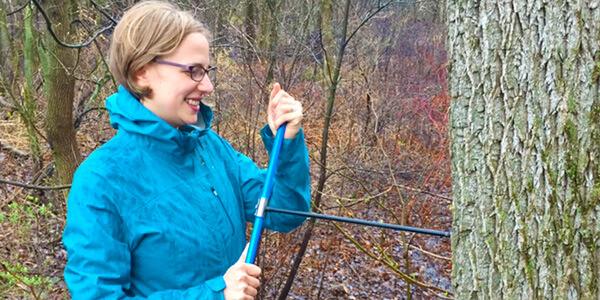Like many budding scientists, I was first inspired to pursue study in an environmental field by an exceptional high school teacher. Wanting to do the same for young learners, I entered the field of science education post-college, in which I taught in both formal and informal settings. Preparing students to face the challenges our planet will encounter with continued greenhouse gas emissions is crucial work. However, after ten years of working in science education, I realized that I wanted to become a bigger agent of change within the science conservation world. I am thrilled to be at RSENR and to be part of a community with such diverse research interests and pursuits.
Forests are inherently dynamic ecosystems, but a range of environmental challenges may now be causing uncertain transformations within forests. Understanding the response and resilience of Northern Forest species to environmental change is critical for future management of our forests. My research includes two separate, though related projects in forest ecology that investigate the growth and adaptation of major tree species within our forests.
The first part of my research addresses the connections between growth and environmental change for key tree species within the Northern Forest. My goal is to quantify if, how, and when the woody growth of important tree species has changed over the past century within the Northern Forest and to link these patterns with environmental data from the region to identify potential drivers of health and productivity using dendrochronology (the study of tree rings). This work will become part of a larger dendrochronology database that our research group is establishing, to link tree ring datasets from across the Northeast and gain a broader understanding of what’s happening in our forests.
The second half of my research focuses on restoration of the American chestnut tree, a species of immense ecological value for forest wildlife that was removed as an overstory species in North American forests by chestnut blight in the early 20th century. Since chestnut played such a vital role in eastern deciduous forests, much effort has been applied to its restoration. In partnership with other institutions, The American Chestnut Foundation is working to produce a blight-resistant chestnut, commonly referred to as the B3F3 restoration chestnut. This chestnut is 15/16th American chestnut and is bred to be blight resistant while maintaining the morphological traits of American chestnut.
In the northeastern U.S., the oak-hickory forest type, which once included chestnut, is predicted to expand, particularly in high CO2 emissions scenarios. The north may therefore be one of the most prominent locations for American chestnut restoration, especially with the continued impacts of climate change. Vermont is in the northern limits of American chestnut’s historical range. If chestnuts are to be successful in this area, they will need to be able to survive freezing temperatures. I will be studying the level and variability of cold hardiness among the B3F3 restoration chestnut. If B3F3 chestnuts are uniformly less cold hardy than straight American chestnuts, then this could pose a significant obstacle to restoration in the north. However, if B3F3 stock exhibit significant variation in their sensitivity to freezing injury, then we can choose specific genetic lines to be established in cold climates.
Being located near the heart of the Northern Forest, UVM offers such a unique opportunity to study this dynamic ecosystem. My research also benefits greatly from some amazing partnerships that RSENR has established with both the state and federal government, as well as NGOs. I am looking forward to our field season coming up — I’ll see you in the forest!
